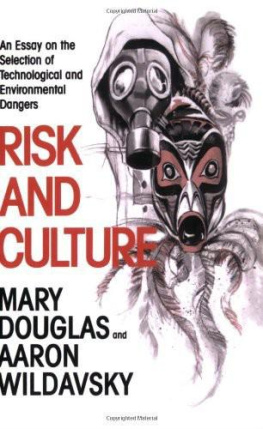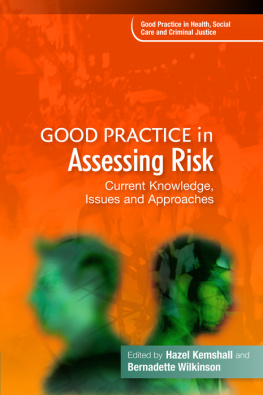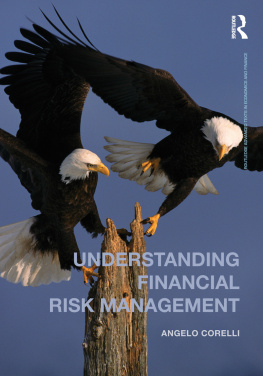MARY DOUGLAS
MARY DOUGLAS: COLLECTED WORKS
VOLUME I
The Lele of the Kasai
VOLUME II
Purity and Danger
VOLUME III
Natural Symbols
VOLUME IV
Rules and Meanings
VOLUME V
Implicit Meanings
VOLUME VI
The World of Goods
VOLUME VII
Edward EvansPritchard
VOLUME VIII
Essays in the Sociology of Perception
VOLUME IX
Food in the Social Order
VOLUME X
Constructive Drinking
VOLUME XI
Risk Acceptability According to the Social Sciences
VOLUME XII
Risk and Blame
MARY DOUGLAS COLLECTED WORKS
VOLUME XI
RISK ACCEPTABILITY ACCORDING TO THE SOCIAL SCIENCES
First published in 1985 by the Russell Sage Foundation
This edition published 2003
by Routledge
2 Park Square, Milton Park, Abingdon, Oxon, OX14 4RN
Simultaneously published in the USA and Canada
by Routledge
270 Madison Ave, New York NY 10016
Routledge is an imprint of the Taylor & Francis Group
First issued in paperback 2010
1985 by the Russell Sage Foundation
All rights reserved. No part of this book may be reprinted or reproduced or utilised in any form or by any electronic, mechanical, or other means, now known or hereafter invented, including photocopying and recording, or in any information storage or retrieval system, without permission in writing from the publishers.
British Library Cataloguing in Publication Data
A catalogue record for this book is available from the British Library
Library of Congress Cataloging in Publication Data
ISBN 978-0-415-29114-9 (hbk) (Volume XI)
ISBN 978-0-415-60675-2 (pbk) (Volume XI)
ISBN 978-0-415-28397-7 (set)
Publishers Note
The publisher has gone to great lengths to ensure the quality of this reprint but points out that some imperfections in the original may be apparent
Introduction
Originally this was intended as a review of the literature on social influences on risk perception. However, it proved difficult to achieve the usual form of a literature review. When there is a large, focused body of work to be abstracted, various outlying areas and innovations can be related within a single framework. In this case the relevant work is found entirely in the outlying areas, and the central core of interest in social influences on risk perception is missing. At the same time a very significant body of work views risk perception as an individual and not as a social phenomenon. To start with, surveying the state of the art in that substantial field would take all the time and attention away from the set project since it turns out that that art is in no state at all. The best strategy seems to be to use the question of risk acceptability to make the case for focusing on social factors as strongly as possible. With the change of title, it becomes obviously necessary to point to the scattered, exceptional places where this focus is employed. It seems that the neglect of culture is so systematic and so entrenched that nothing less than a large upheaval in the social sciences would bring about a change.
The subject matter of these pages is strictly described by the title. It is not about risks. Those who want to learn about the risks we face in the present day are advised to read no further. It is not about risk management. Those who want to learn how to handle risks of any kind should save their time and read no more. These notes are about perception as treated in the various social sciences, and the particular focus is upon risk perception according to the social sciences.
Purity and Danger (Douglas 1966) presented an anthropological approach to human cognition which this volume develops. The argument is that humans pay attention to a particular pattern of disasters, treating them as omens or punishments. On this argument there would always be a mutual adaptation of views about natural dangers and views about how society works: Rewards and punishments are stored in the environment. Purity and Danger was well received except for the damning reservation that its argument does not apply to enlightened Western society.
In 1978 Aaron Wildavsky, then president of the Russell Sage Foundation, inquired whether anthropology made its cultural analyses only for tribal peoples and ancient civilizations. Are we moderns always exempted from its hypotheses? He was concerned to interpret a cultural change in contemporary America: the new awareness of technological dangers. It was a privilege to collaborate with him in working out the argument of Risk and Culture (Douglas and Wildavsky 1982). Although both books stand in the respectable tradition of Durkheim and Mauss, Risk and Culture has struck competent reviewers as either novel or outrageous, and always as difficult. So it seemed important to examine the contrary intellectual tide against whose currents the argument about social influences on cognition has so little force. Hence the intended literature review. Close inspection reveals no tide, but some inertia; no contrary currents, but some timidity.
Sometimes the curiosity of scholars fastens steadily upon certain formulations and problems, to the neglect of others. There is enough agreement among psychologists that when this happens there is nothing haphazard about it. The sociology of perception (which includes the history, philosophy, and sociology of science and the sociology of everyday knowledge) is especially interested in persisting gaps in information. We may expect some random patches of inattention because of the impossibility of attending to everything at once. But regularly scheduled obliviousness is more intriguing. Persistent shortsightedness, selectivity, and tolerated contradiction are usually not so much signs of perceptual weakness as signs of strong intention to protect certain values and their accompanying institutional forms. The current gaps in research in risk perception can be used as a paradigmatic example. Intellectual activity takes place in history. No way of knowing is privileged from contemporary cultural pressures. Gaps and contradictions in a system of thought are a good guide to the institutional fabric which supports it and to which it gives life.
The professional discussion of cognition and choice has no sustained theorizing about the social influences which select particular risks for public attention. Yet it is hard to maintain seriously that perception of risk is private. Nor can it be maintained that culture is so static that it can be bracketed away. Large cultural changes since 1969 are precisely the problem. The social bases of credibility need to be systematically studied, but because the individual perceiver is supposed to be out on his own, the culturally constructed lines between reality and fiction and between nature and culture are treated as self-evident. In consequence, risk perception studies stay within the very confines they are instituted to transcend.
With no link between cultural analysis and cognitive science, clashes inevitably occur between theory and evidence. Since the theory is not being radically adjusted, irrationality tends to be invoked to protect the too narrow definition of rationality. So instead of a sociological, cultural, and ethical theory of human judgment, there is an unintended emphasis on perceptual pathology.
Regrettably, this report cannot claim completeness or even up-to-dateness as it goes to press. The field to be sampled is too diverse and the project seems to have moved down one blind alley after another. The best that can be hoped is that no systematic, sociological approach to perception has been overlooked.






